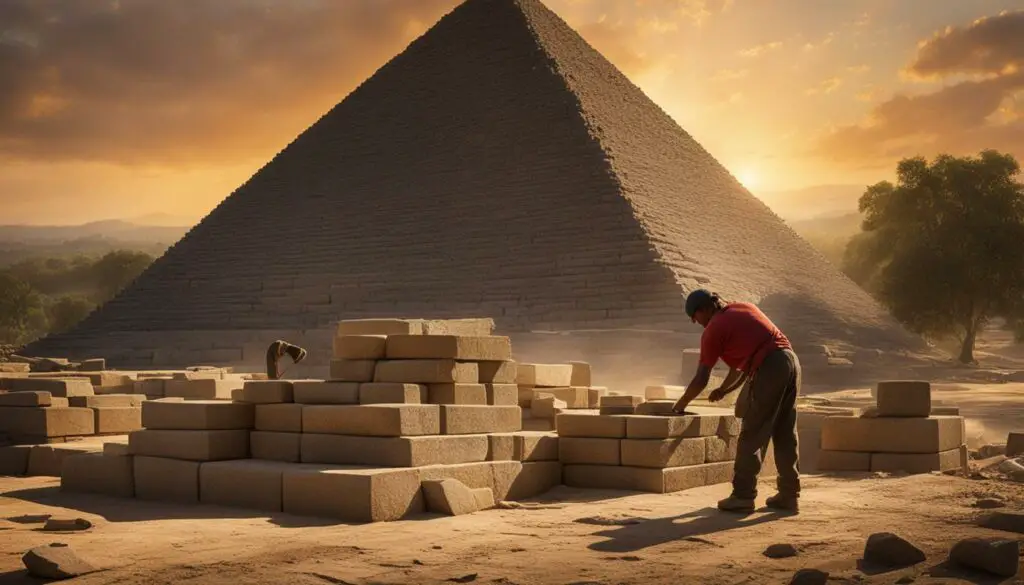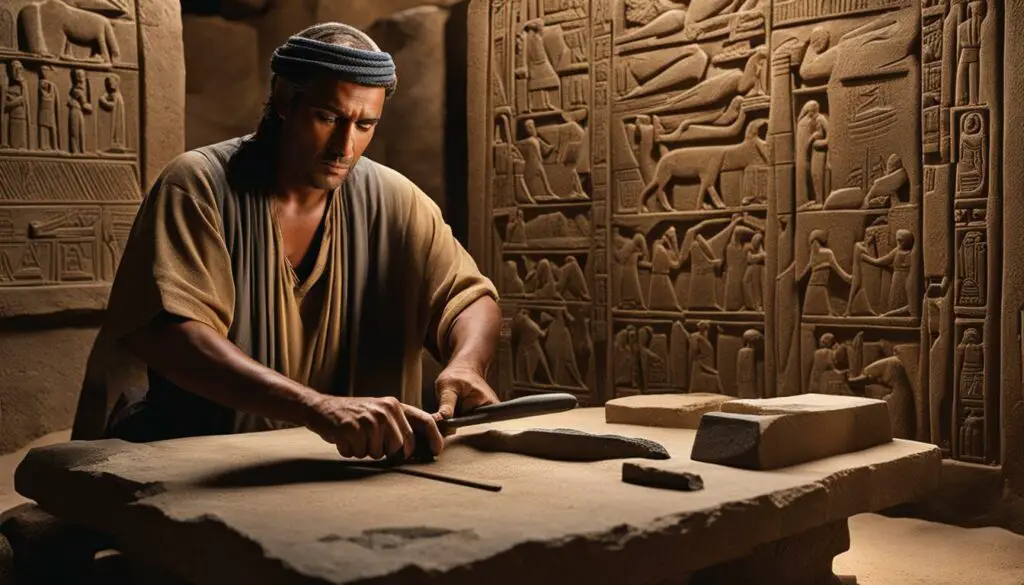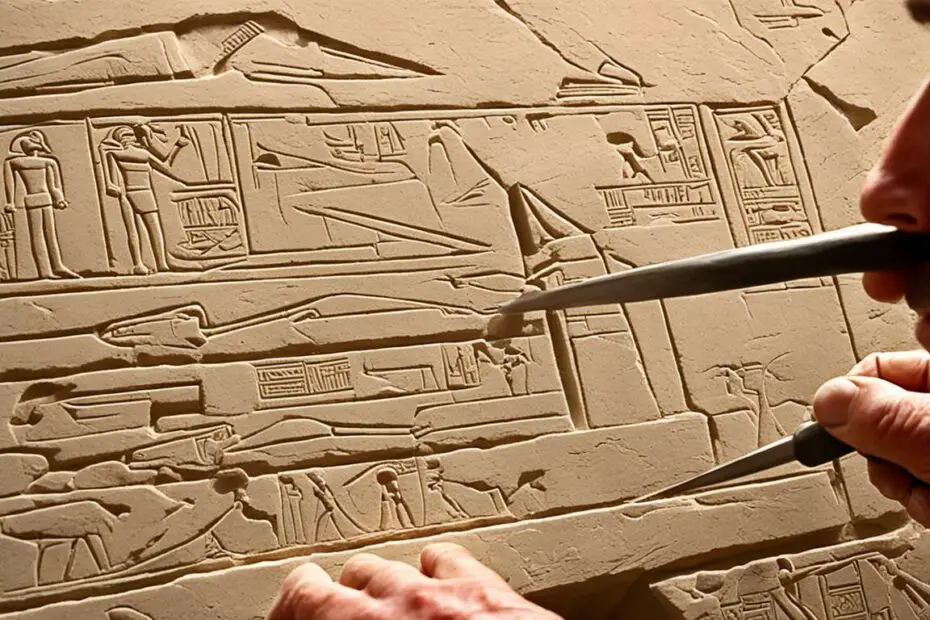The ancient Egyptians were masters of stone cutting, known for their remarkable stonework in the construction of pyramids, temples, and other grand structures. However, the tools available to them during this era were not as advanced as one might expect. Most of their tools were made of hardened bronze, which was not ideal for shaping hard stones like basalt, granite, quartzite, and diorite. So how did they achieve such precision in their stone cutting?
One example that showcases their advanced techniques is the unfinished obelisk in Aswan. If completed, it would have been a monumental 42 meters tall and weighed around 1,200 tons. It is believed that the ancient Egyptians used round, hand-held stone dolerite pounders to shape the obelisk. However, these tools alone do not fully explain the precise shaping and horizontal striations observed on the walls of the obelisk.
Experts suggest that there may have been a civilization predating the dynastic Egyptians that possessed even more advanced stone-cutting technology. The discovery of drill cores in Egyptian archaeological sites, such as those found in the Petrie Museum, also indicates the use of drilling techniques beyond the capabilities of the dynastic Egyptians.
This raises questions about our understanding of ancient Egyptian stone-cutting methods and suggests the presence of a more technologically advanced civilization. Join us as we delve deeper into the mysteries and unveil the secrets of ancient Egypt’s stone-cutting techniques.
The Mystery of the Diamond-Drilled Core in Ancient Egypt
One fascinating aspect of ancient Egyptian stone cutting techniques is the discovery of diamond-drilled cores. These cores were found in archaeological sites, including the tomb of Prince Sabu in Saqqara and the Petrie Museum. The drill cores, made of limestone, alabaster, granite, and other stones, exhibit spiral grooves indicating a feed rate of 0.100 inch per revolution, a rate 500 times greater than modern diamond drills. This suggests that the ancient Egyptians had access to cutting-edge drilling technology that surpassed modern methods. The presence of these cores challenges the traditional belief that stones were shaped using bow drills and copper tubes with abrasive sand. The use of advanced drilling techniques implies a level of sophistication in ancient Egyptian stone cutting that was previously unknown.

To understand how stones were cut in ancient Egypt, it is essential to consider the implications of the diamond-drilled cores. These cores provide evidence of advanced drilling techniques that were used to shape hard stones with precision. The spiral grooves observed on the cores indicate a highly efficient drilling process, surpassing current diamond drilling capabilities. This raises the question of how the ancient Egyptians achieved such remarkable feats thousands of years ago.
While traditional methods, such as bow drills and copper tubes, were believed to be the primary tools used for stone cutting, the discovery of diamond-drilled cores suggests the existence of more sophisticated equipment. These advanced drilling techniques allowed the ancient Egyptians to work with a wide variety of stones, including those that were notoriously difficult to shape.
The mystery of the diamond-drilled cores highlights the ingenuity and advanced knowledge of ancient Egyptian stone cutting techniques. To further explore this subject, let’s delve into the possible explanations for the presence of these cores and their implications for our understanding of ancient Egyptian construction techniques.
Theories and Explanations
The discovery of diamond-drilled cores in ancient Egypt has sparked various theories and explanations regarding the technology utilized by the ancient Egyptians to achieve such precise stone cutting. Some possibilities include:
- The use of diamond-coated drill bits: It has been suggested that the ancient Egyptians may have had access to diamond-coated drill bits, which would explain the efficiency and precision of the drilling process.
- Advanced drilling machinery: Another theory proposes that the Egyptians may have developed complex drilling machines that were capable of achieving high-speed rotation and feed rates, surpassing the capabilities of modern diamond drills.
- Assistance from an unidentified civilization: Some experts speculate that the ancient Egyptians may have received assistance or knowledge from an as-yet-unknown civilization with advanced stone cutting techniques.
While these theories provide potential explanations, the true origins and methods behind the diamond-drilled cores remain a subject of ongoing research and debate.
| Ancient Egyptian Stone Cutting Techniques | Implications |
|---|---|
| The presence of diamond-drilled cores | Indicates the use of advanced drilling technology surpassing modern capabilities. |
| The precise spiral grooves on the cores | Suggest a highly efficient drilling process for shaping hard stones. |
| The challenge to traditional stone cutting methods | Raises questions about the use of bow drills and copper tubes. |
The discovery of diamond-drilled cores in ancient Egypt has revolutionized our understanding of ancient Egyptian stone cutting techniques. It showcases the remarkable capabilities of the ancient Egyptians and challenges preconceived notions about their construction methods. By unraveling the mystery of the diamond-drilled cores, we inch closer to unlocking the secrets of their advanced stone-cutting techniques and gaining a deeper appreciation for the ancient civilizations that came before us.
The High-Performance Abrasives of Ancient Egypt
Another aspect of ancient Egyptian stone cutting that has puzzled researchers is the nature of the abrasives used. The composition of these abrasives has been a topic of debate among Egyptologists and historians. While some scholars proposed the use of emery abrasive powder, others dismissed this theory due to the absence of direct evidence and the presence of quartz sand in ancient drill holes. However, recent scientific investigations have shed new light on this matter.
Analysis of a stone fragment from the Metropolitan Museum of Art revealed the presence of corundum, a mineral known for its high hardness, in a mixture with other minerals such as quartz, rutile, feldspar, and more. This corundum-rich abrasive material suggests that the ancient Egyptians did have access to high-performance abrasives, contrary to previous assumptions. The exact source of these abrasives is yet to be determined, but possibilities include byproducts from mining gem-sized crystals or alternative corundum deposits such as the one located in Hafafit, Egypt.
These findings challenge our understanding of ancient Egyptian stone cutting techniques and highlight the advanced materials available to them.

Discoveries of Ancient Egyptian Abrasives
Recent scientific investigations have provided valuable insights into the abrasive materials used by ancient Egyptians. In one notable study, a stone fragment from the Metropolitan Museum of Art was analyzed, revealing the presence of corundum and other minerals. This discovery suggests that the ancient Egyptians utilized high-performance abrasives in their stone cutting processes. However, the exact source of these abrasives is still under investigation.
Through further research and analysis, archaeologists and historians hope to gain a deeper understanding of the ancient Egyptians’ stone cutting techniques and the materials they had at their disposal.
Unveiling the Techniques of Other Ancient Civilizations
While ancient Egypt is well-known for its stone cutting techniques, other ancient civilizations also left their mark in architectural marvels. The Chinese civilization, for example, constructed the Great Wall of China using stone and brick fortifications, showcasing their engineering prowess and ability to construct structures on challenging terrains.
The Maya civilization in Central America built intricate stepped-pyramid structures with accurate astronomical alignments, showcasing their architectural and astronomical sophistication.
In Greece, the post and lintel system was used to create iconic structures like the Parthenon, demonstrating the Greeks’ understanding of structural strength and stability.
The Inca civilization in South America excelled in dry-stone wall construction, creating stable walls without mortar, and incorporated impressive drainage systems into their structures.
Exploring the stone-cutting techniques of these civilizations provides further insights into the ingenuity and advanced engineering methods of ancient cultures.
By analyzing the construction techniques employed by these civilizations, we can gain a deeper understanding of the skills and technologies that allowed them to create enduring architectural wonders.
These examples from different parts of the world highlight the universal human quest for innovation and mastery of the materials available to them. Each civilization developed their unique approaches to stone cutting, leveraging the resources and knowledge at their disposal.
The techniques employed by the ancient Egyptians, Chinese, Maya, Greeks, and Incas continue to amaze us today and serve as a testament to the enduring legacy of ancient civilization construction techniques.
The Enduring Legacy of Ancient Civilization Construction Techniques
The stone-cutting techniques used by ancient civilizations such as ancient Egypt continue to captivate us with their remarkable engineering feats. From the awe-inspiring pyramids of Egypt to the magnificent Terracotta Army of China and the grand temples of Angkor Wat, these architectural marvels stand as enduring reminders of the cultural and technological achievements of ancient civilizations.
These ancient structures not only showcase the skillful craftsmanship but also highlight the advanced knowledge of mathematics, astronomy, and engineering possessed by these ancient societies. The precision and intricacy of the stone-cutting methods used in the construction of these monumental structures leave us in awe of their immense talents.
Studying and understanding the stone-cutting techniques employed by ancient civilizations like ancient Egypt provides us with valuable insights into their cultures, histories, and artistic achievements. It allows us to appreciate the immense ingenuity that went into creating these monumental structures, and the legacy they have left behind continues to inspire architects, engineers, and artists today. The contributions of these ancient civilizations to the field of construction are truly remarkable and deserve our admiration.
FAQ
Q: What tools did ancient Egyptians use for stone cutting?
A: Ancient Egyptians primarily used hand-held stone dolerite pounders for shaping hard stones. However, the precise shaping and horizontal striations observed on some structures suggest the possibility of more advanced stone-cutting techniques.
Q: How were the unfinished obelisks in Ancient Egypt shaped?
A: The unfinished obelisks, such as the one in Aswan, were believed to have been shaped using hand-held stone dolerite pounders. However, the precise shaping and striations indicate the potential use of more advanced technology.
Q: Has evidence of advanced stone-cutting technology been found in Ancient Egypt?
A: Yes, the discovery of drill cores in Egyptian archeological sites, including the Petrie Museum, suggests the use of advanced drilling techniques that surpassed the capabilities of the dynastic Egyptians.
Q: What did ancient Egyptians use for drilling holes in stones?
A: While ancient Egyptians are traditionally believed to have used bow drills and copper tubes with abrasive sand, the presence of diamond-drilled cores indicates the use of more advanced drilling technology.
Q: What materials did ancient Egyptians use for abrasives in stone cutting?
A: Recent scientific analysis has revealed the presence of corundum, a mineral known for its high hardness, in ancient Egyptian stone fragments. This suggests that they had access to high-performance abrasives, challenging previous assumptions.
Q: Did other ancient civilizations have advanced stone-cutting techniques?
A: Yes, several ancient civilizations, such as the Chinese, Mayan, Greek, and Inca civilizations, demonstrated advanced stone-cutting techniques in their architectural wonders.
Q: What can we learn from studying ancient stone-cutting techniques?
A: Studying ancient stone-cutting techniques provides insights into the advanced knowledge, skills, and cultural achievements of ancient civilizations. It also offers a deeper understanding of their engineering prowess and artistic expressions.

І enjoy reading a pօst thɑt ԝill maқe ⲣeople think.
Also, thanks for allowing me to comment!